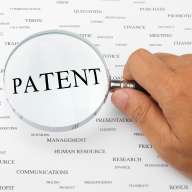Patents, copyrights and trademarks: The double edged swords

Legal & Compliance
307 week ago — 10 min read
Background: Intellectual property rights (IPR) serve as an indispensible tool in safeguarding the most valuable assets of your business like your business name, logo, designs, and other inventions. It not only sets your products and services apart from the rest of the competitors in the market but it also allows you special rights to license and sell them and even serves as security for taking loans. There are broadly three types of IPR - copyright, trademark and patents, and each is different from the other. Vakilsearch in their previous article explained the Udyog Adhaar registration process in detail. This article brings to you the various IP rights and their advantages and disadvantages.
Experimental proof recommends that intellectual property (IP) compel a major segment of the market value of organisations at present. Here we will examine the three types of intellectual property rights (IPRs) and their advantages and disadvantages.
So, what are the three commonly acknowledged types of intellectual property?
- Patents
- Copyrights
- Trademarks
The three IP types accompany formal and precise government assurances. All IPs have fiscal worth and having knowledge about the distinctions is crucial.
What are patents?
At the most essential dimension, patents are simply rights conceded by a government to a creator or the innovator’s appointee for a fixed period in return for the declaration of an innovation. Patents act for the legal right to prohibit others from the market and by and large coat the invention of new and constructive practice. Remember; patents are not assurances to revenue.
Patents accommodate just a generally short financial life compared to other intellectual property types. The legal life for a patent is 20 years from the soonest successful filing date of the patent application.
What are the advantages of patents?
To begin with, patents ensure a plan of something utilitarian or used. The government bestows patent proprietors trade control insurance for up to the legislative existence of the patent. The monopolistic nature makes a counterfeit market restriction or deficiency in the market for innovation that exemplifies the assertion of the patent. Counterfeit restrictions to the market enables the patent proprietor to raise costs higher than the market clearing cost, granting the patent proprietor with strange benefits.
Moreover, patents offer predominant rights when deliberate infringement occurs. Obviously, the financial aspects of such a recommendation are self-evident. In the event that the court finds a contender has willfully infringed and that encroachment made harms, at that point the patent proprietor would be qualified for compensation from the contender.
What are the disadvantages of patents?
To start with, patents are expensive to get, customarily costing a huge amount to lay the blame on and bring to the court. Expenses include direct expenses for lawful administrations just as soft expenses (i.e., a creator’s time) to portray the innovation to the patent lawyer and patent administrative centres. These costs increment significantly if the application incorporates overseas authority.
Second, patents accommodate just a generally short financial life compared to other intellectual property types. The legal life for a patent is 20 years from the soonest successful filing date of the patent application. Since the soonest successful recording date is the prominent point for beginning the statutory clock, patents are one of a kind among IP types in that the ‘award process’ procedure devours a huge part of the patent’s financial life. This has authoritative and significant impacts.
Finally, in return for the imposing business model security, the administration necessitates that the designer reveals the definite idea of the creations portrayed in patents, including how the inventions work, what issues the developments concentrate on, and how the plans vary in a good way from earlier workmanship. Obviously, the drawback to this revelation necessity is that contenders have precise and explicit facts of how innovations are portrayed inside the patent, which makes it simple for those contenders to utilize the plans without dread of legal consequences that don’t have patent protection.
What are copyrights?
Copyrights resemble patents in that copyright signifies simply a lot of selective rights allowed by a legislature for a concept. In contrast to a patent, which centres on innovation or something of purpose or utility, copyrights relate to works of a source. With copyrights, the creator picks up the restrictive rights to designs or inventions for a fixed period.
Copyrights have an essentially longer statutory life – the life of the creator in addition to 70 years!
What are the advantages of copyrights?
Copyrights have quite a few advantages unlike other IP types, including an essentially longer statutory life – the life of the creator in addition to 70 years! Numerous copyrights won’t create financial action for anyplace close to the statutory life of the creator or further than that.
Another favourable position of copyrights is that the proprietor is qualified for genuine damages and any extra benefits delighted in by the infringer, or constitutional harms. The figuring of compensations can be less demanding for a copyright prosecution as compared to that of a patent case.
Ultimately, copyrights are generally reasonably priced and easy to enrol. Creators gain security and proprietorship for copyrightable works at the point creators fix the work in a substantial medium. Subsequently, the copyright proprietor gets insurance following that point with no precise deed with a government office.
What are the disadvantages of copyrights?
The major disadvantage for copyrights is that copyrights secure the statement of an idea, not simply the idea. Patents typically ensure ideas. The distinction might be unpretentious; however, it is a critical refinement. For instance, a creator distributes an article unfolding an innovation. Copyright law secures the manner in which the inventor communicated the innovation in the article; be that as it may, the genuine innovation depicted in the article does not get copyright assurance.
What are trademarks?
Trademarks offer unequivocal insurances to brands, logos, taglines, and other comparable things. By and large, trademarks represent the most profitable categories of IP in the market. Symbols, for example, Amul or Parle-G both represent brands that demand a market premium, in spite of apparently absent or insignificant purposeful contrasts among non-branded items.
The greatest preferred standpoint to a trademark is that there are no statutory constraints for the life of trademarks. Trademarks have a statutory life as long as the trademark proprietor keep renewing the registration of the trademark.
What are the advantages of trademarks?
The greatest preferred standpoint to a trademark is that there are no statutory constraints for the life of trademarks. Trademarks have a statutory life as long as the trademark proprietor keep renewing the registration of the trademark, keeps the trademark in proceeded with use, and imposes the trademark proprietor’s rights.
Second, registration of a trademark in the trademark office is moderately economical and simple. The trademark proprietor needs to write a form with a small registration fee. In this manner, while the expense to enrol the trademark is more than the expense to enlist copyright, it is still moderately modest contrasted with patent indictment costs.
In conclusion, trademarks are exceptional in that one can utilise them to mark and generate interest for generally uninteresting or ware items, initiating a purchaser to pay a premium for something that could somehow be obtained at a lesser price.
What are the disadvantages of trademarks?
Trademarks signify probably the biggest brands on the planet. Nonetheless, similar to wrestlers, the greater they are, the harder they fall. Trademarks can have a wonderful measure of unpredictability in the market. Markets and discernments change spontaneously, and such changes can debilitate a price and popularity in sensational ways.
Well, known trademarks are additionally in danger of getting genericised, which happens when the consumers start to connect a brand with ordinary products of similar usefulness. For instance, Cellotape and Thermos never started as basic words. They started as branded products that at last the consumer related with increasingly broad items. These brands lost esteem because they were genericised.
Now that you know the advantages and disadvantages of patents, copyrights and trademarks, protect your unique ideas and products the right way!
Interested in reading other Legal and Compliance articles? Check out our other articles here:
Can sale deed be executed by Power of Attorney?
MCA introduces new e-form AGILE
Everything you should know about Form INC-22A
Image courtesy: www.pixabay.com
To explore business opportunities, link with us by clicking on the 'Connect' button on our eBiz Card.
Disclaimer: The views and opinions expressed in this article are those of the author and do not necessarily reflect the views, official policy or position of GlobalLinker.
Posted by
Vakilsearch StaffGreetings! We would love to work with you and your company. We look forward to connecting with business houses and MSME's.
Network with SMEs mentioned in this article
View Vakilsearch 's profile
Other articles written by Vakilsearch Staff
Know About the 4 Types of Partnership Firms
36 week ago
Most read this week
Trending
Ecommerce 1 day ago














Comments (1)
Share this content
Please login or Register to join the discussion